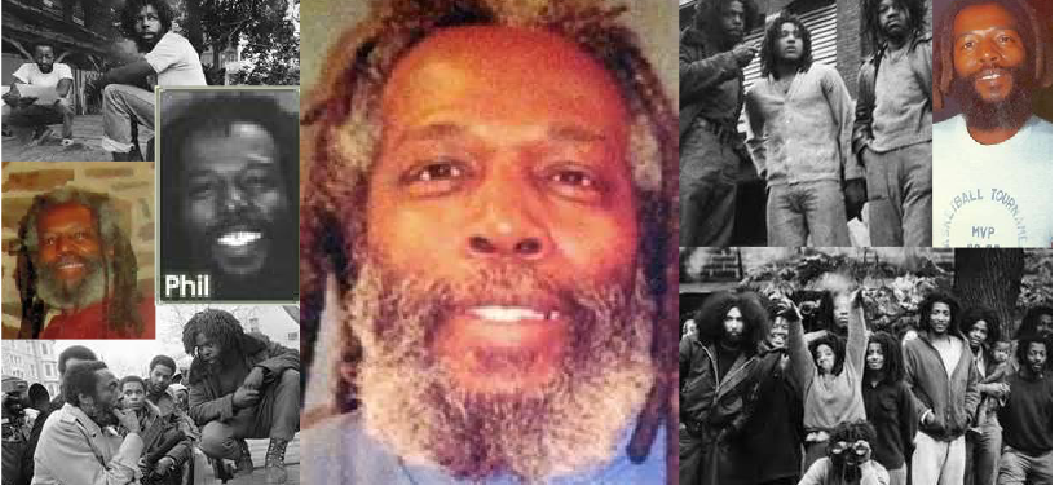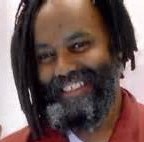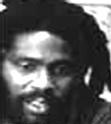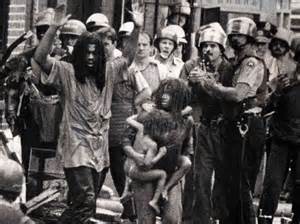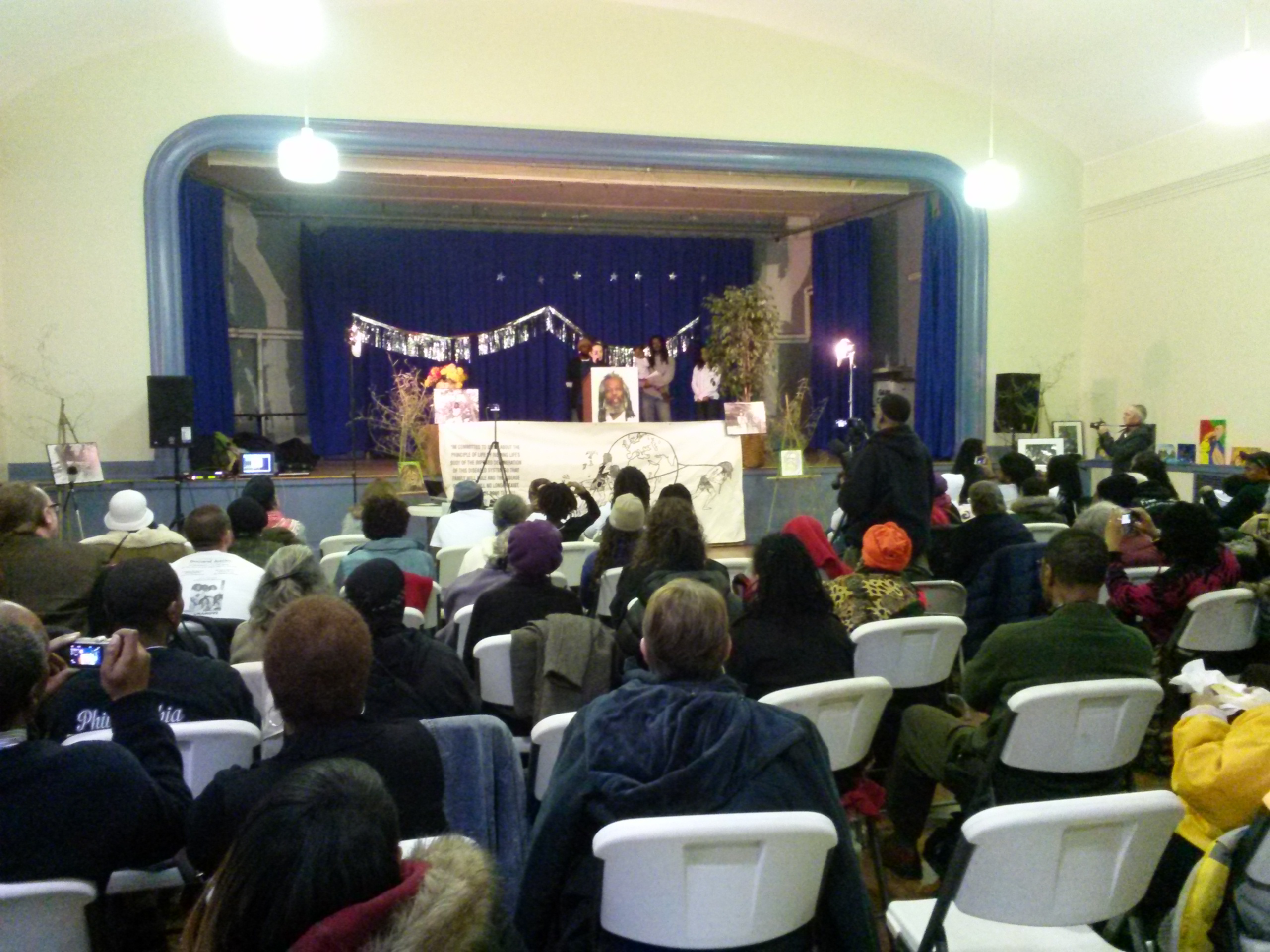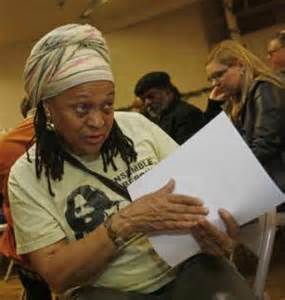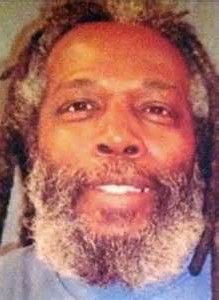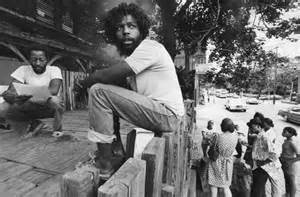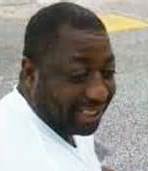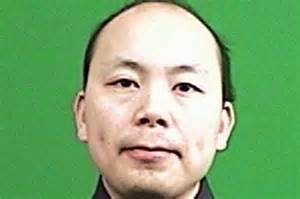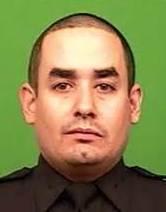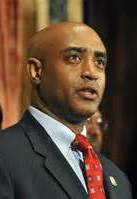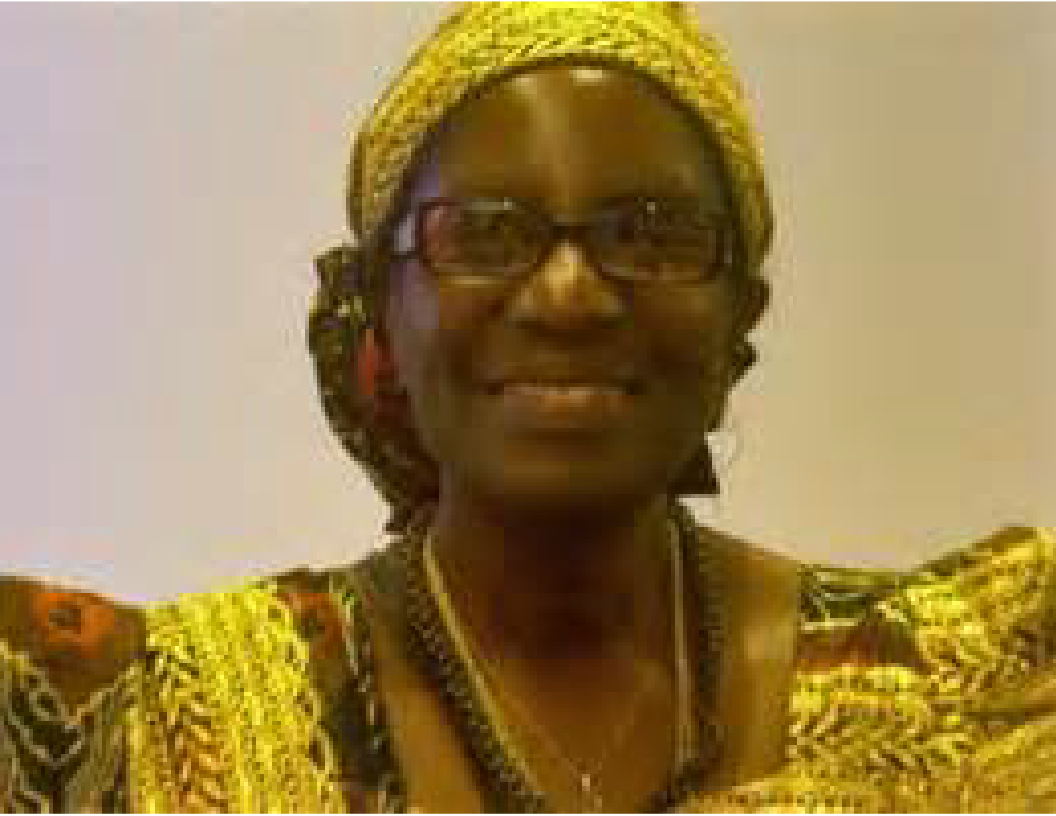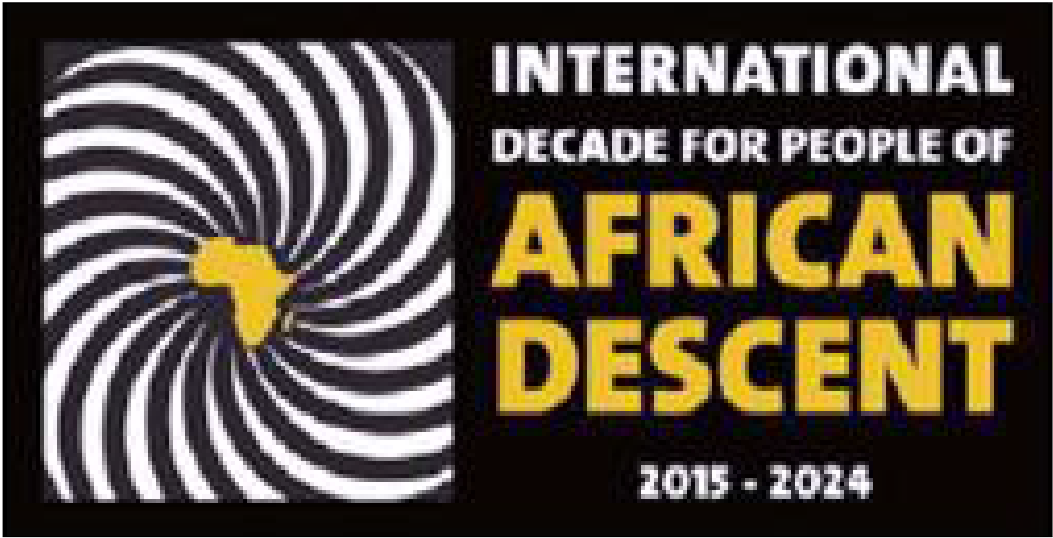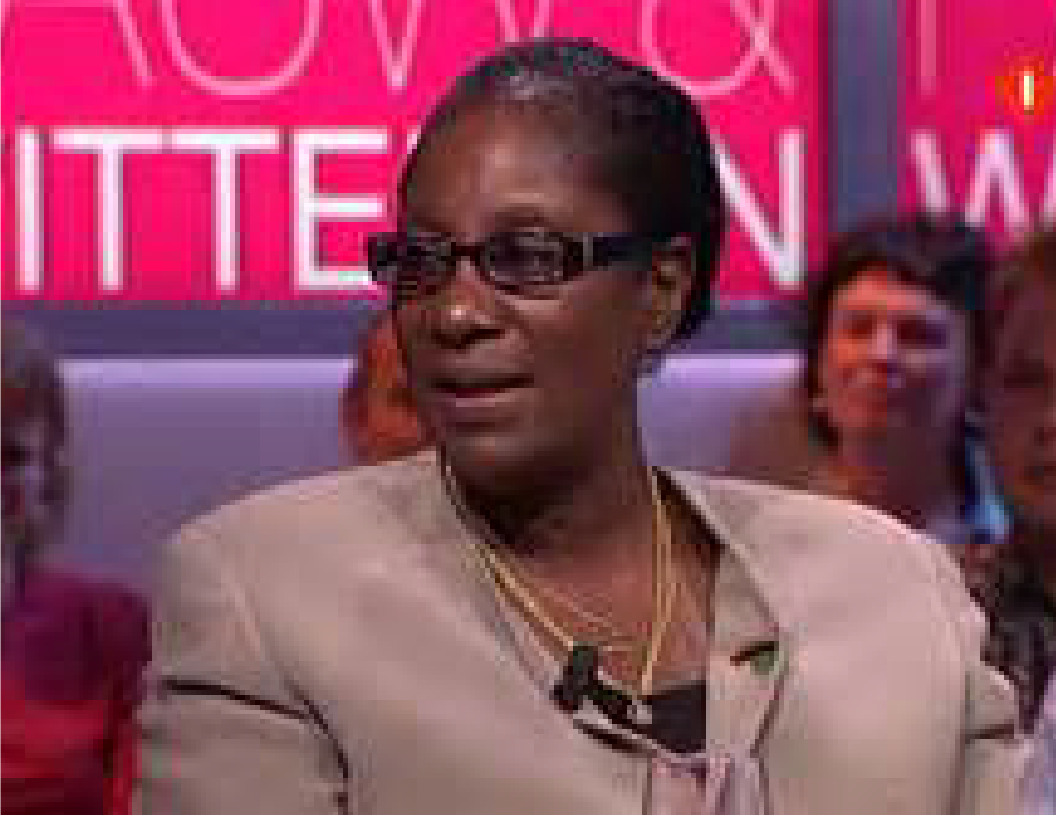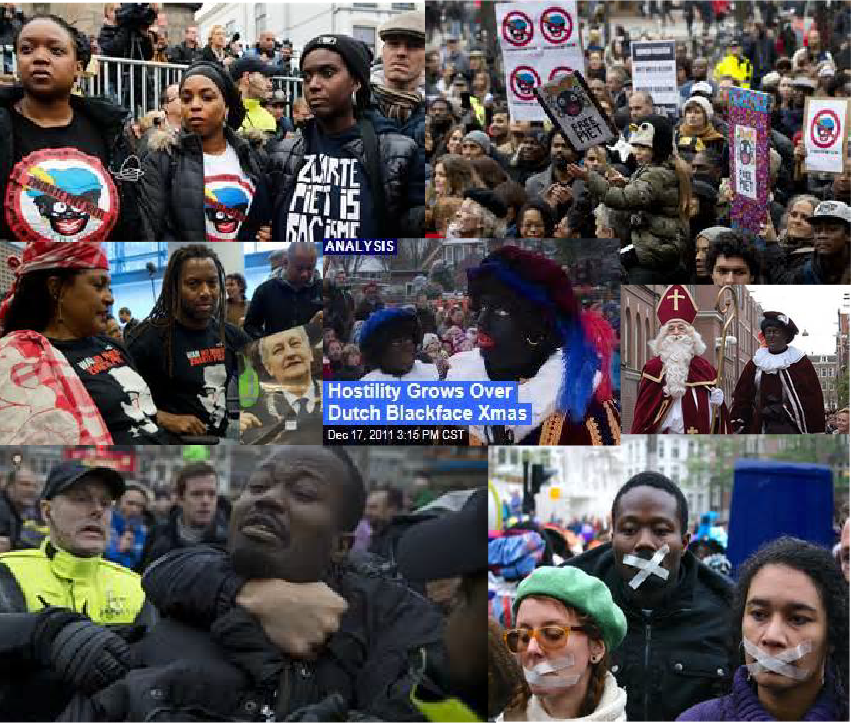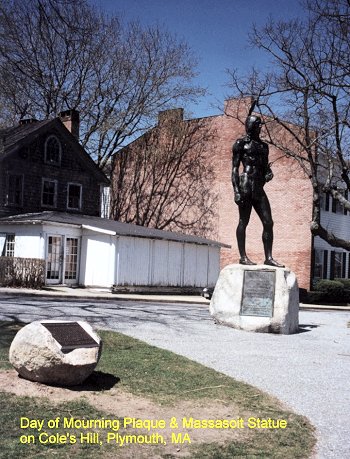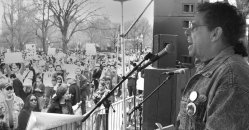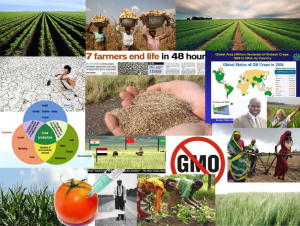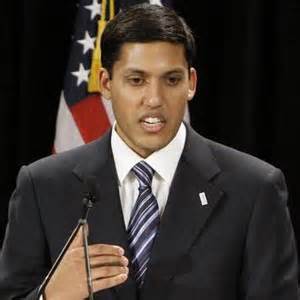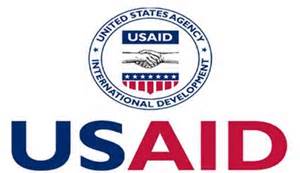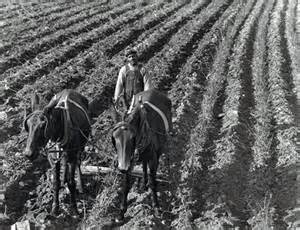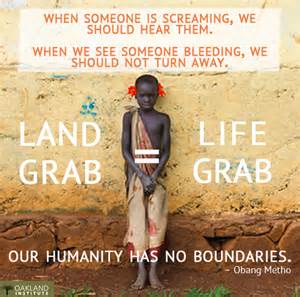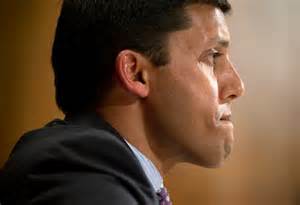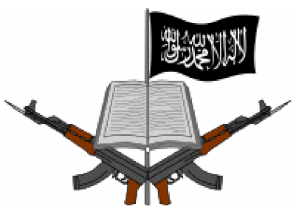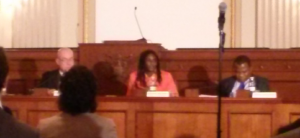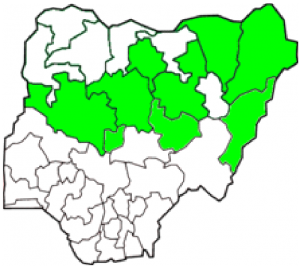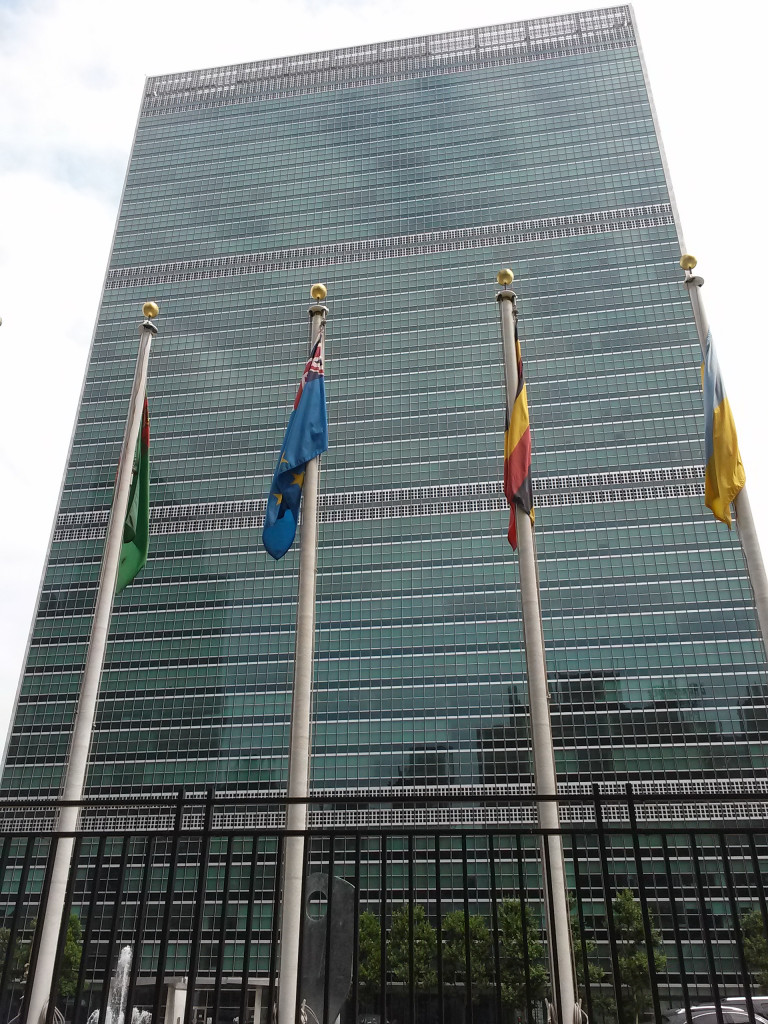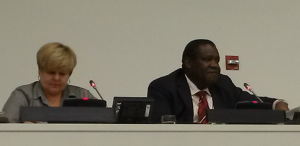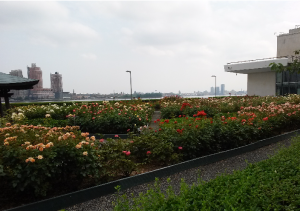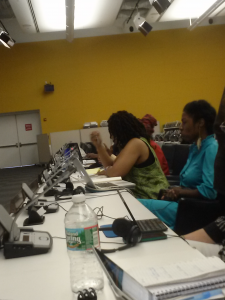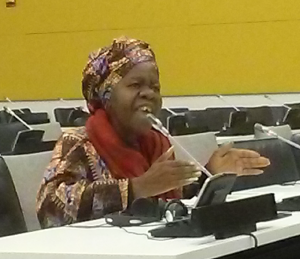from the BFAA 2015 Land Loss Summit
Blackburn Center, Howard University
February 20 – 21, 2015
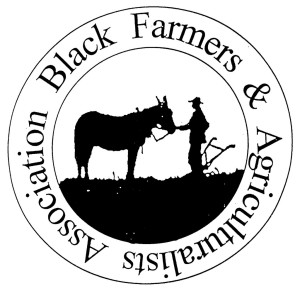
The Black Farmers and Agriculturalists Association (BFAA) was founded in 1997 “to respond to the issues and concerns of Black farmers in the United States and abroad [and] to monitor the US Department of Agriculture and the historic 1999 Class Action Lawsuit Settlement Pigford v. Glickman, which was to award Black farmers $2.5 billion in damages for loan discrimination practices by the federal government” (from the website http://www.bfaa-us.org). However, as of May 2002, most of the farmers who had filed had still not received their awards and the USDA’s discriminatory practices against Black farmers continued. Not only did this lead to the Pigford II Settlement to enforce the award of the full $2.5 billion in damages, it has led many Black farmers to declare the entire Pigford Class Action fraudulent and has fueled continued resistance from America’s farmers of Afrikan descent.
In this first article of several on the 2015 Black Land Loss Summit and the continuing struggle of the Black Farmer in the United States, we present the statements of two individuals who have worked long and hard on the original Pigford Settlement and now are involved in the continuing struggle for justice. They also present somewhat different perspectives on the relevance and importance of the Pigford lawsuit. First, however, a summary and discussion of the Pigford I and II Class Action Lawsuits is in order.
A Brief Summary of the Pigford I and Pigford II Class Action Lawsuits
The following explanation of the two class action lawsuits initiated by Black farmers against the United States Department of Agriculture (USDA), beginning in 1997, comes from the publication Black Farmers United: The Struggle Against Power and Principalities, by BFAA President Gary R. Grant, Kansas State University Assistant Professor of Sociology Spencer D. Wood, and UNC Chapel Hill doctoral candidate Willie J. Wright (The Journal of Pan African Studies, vol.5, no.1, March 2012, http://www.jpanafrican.com/docs/vol5no1/5.1BlackFarmers.pdf).
In 1997 Pigford I was levied against former Secretary of Agriculture Dan Glickman and the USDA. The lead plaintiff, Timothy Pigford, was a Black farmer from Cumberland County, North Carolina, but the lawsuit represented the interests of African-American farmers throughout the country. Pigford I makes two points: first, that agents within the FmHA discriminated against Black farmers by denying their requests for loans or farm benefits without just cause, and that the FSA failed to service African-American farmers’ loans in a timely manner or to offer other USDA programs that could prevent them from losing their farm operations, land, and in many cases their homes through foreclosure (Pigford 1997). It often goes unstated that many litigants were never afforded the opportunity to become farmers because they were unfairly prevented from receiving the financial credit required to purchase land, equipment, and other farm necessities.
Second, the litigants posited that once informed of the prejudicial decision-making practices of his employees, former Secretary of Agriculture Dan Glickman failed to take swift and appropriate action toward addressing these claims (Pigford 1997). Shortly after the filing of Pigford I, Cecil Brewington, another African-American farmer from North Carolina, filed a second lawsuit, which was subsequently combined with the previous suit to complete Pigford I (Brewington et al. 1997). This original lawsuit only accepted discrimination claims from litigants who experienced racial bias and professional misconduct between January 1, 1981 and December 31, 1996 (Pigford 1997). While discrimination certainly occurred before 1981 and, sadly since 1997, the lawsuit covers those years because during that time the offices of the Civil Rights Division of the US Department of Agriculture were unstaffed. Consequently, when farmers filed complaints, they were not officially investigated nor addressed as the office was closed. With no staff, it was impossible for grievances to be fairly investigated and resolved.
After mounting evidence and emotional testimonies, Pigford I was separated into two tracks. Track A required farmers submitting discrimination claims to fulfill a relatively low burden of proof, and allowed farmers whose claims had been proven to collect a maximum payment of $50,000 and possible debt relief. The second track, Track B, allowed unlimited payout and debt relief, but required a preponderance of evidence to justify payment from the government (Pigford 1997).
In 1999 Federal Judge Paul Friedman authorized a consent judgment for $1.25 billion for litigants in Tracks A and B of Pigford I resulting in the largest class-action Civil Rights settlement in the history of the country (Pigford et al. v. Glickman 1999). More than 700 black farmers representing the tens of thousands of absent farmers were at the courthouse to hear the decision. Timothy Pigford, along with the other six lead plaintiffs, and more than forty other farmers, activists, including the National Association for the Advancement of Colored People (NAACP) and other Civil Rights groups spoke against the consent judgment during what was called the “Fairness Hearing.” Black farmer organizations and activists widely believed that the consent judgment hammered out between attorney Alexander J. Pires Jr., for the plaintiffs, the USDA, and Michael Sitcov, the U.S. Department of Justice’s lead attorney, would be the final nail in the coffin of African-American farmers in America. Specifically, farmers and their advocacy groups argued that fifty thousand dollars was insufficient to compensate fully for the value of lost land. Furthermore, there were no provisions in the settlement for the return of any land nor was there a provision to work out settlements for farms currently in foreclosure. Last, the farmers were concerned that the settlement did not give a proper debt forgiveness process and that many would have additional tax burdens as the awards and debt forgiveness were interpreted as income.
Following years of protests, deliberations, testimonies, and interviews, on April 14, 1999 Judge Paul Friedman concluded that “the consent decree is a fair, adequate, and reasonable settlement for the claims brought in this case” (General Accounting Office 2006: 1). Due to inconsistencies in the filing date issued by the USDA, soon thereafter, additional claims argued that many farmers were left out of the Pigford I settlement. The discrepancy occurred because the USDA did not clarify whether claims were to be received by September 14, 1999 or if they were to be postmarked by this date. There was also the argument that the method used by the USDA to notify farmers of the lawsuit was not adequate enough to reach many elderly African-American farmers in the south, most of whom were without internet and computer access and skills. This gaffe resulted in many farmers being denied admittance into the original civil suit and ultimately led to an extension of the case now known as Pigford II.
On November 30, 2010 after having been defeated eight separate times in the U.S. Senate, both houses of the U.S. Congress finally passed a bill to provide compensation for African-American farmers who were late to file discrimination claims in accordance with Pigford I. On December 8, 2010, President Barack Obama signed into law SB Bill 3838 approving the allocation of an additional $1.15 billion as a final settlement to Black farmers. The bill also provided provisions for an additional $100 million made available by the Credit Commodity Corporation for credit program discrimination claims that were in violation of the government’s Equal Credit Opportunity Act (GPO 2010).
Despite the court-approved settlement for the plaintiffs, the legislation that followed, and a preponderance of independent and federally documented evidence, there are still those who contend that the claims of discrimination made by thousands of African-American farmers across the country are fraudulent (Beck, 2011; March 2004). During a meeting in Washington, D.C. with Secretary of Agriculture Tom Vilsack in November of 2010, the Secretary told the authors of this paper, along with other leaders in the Black Farmer Movement, that there were actually legislators who did not believe that any discrimination ever occurred between USDA officials and African-American farmers and aspiring farmers. The pervasive distribution of this sentiment helps to explain why it took eight proposed bills in the U.S. Senate before Congress approved legislation to allocate funding for Pigford II.
Notably, SB 3838 was attached to the settlement of Cobell et al., v Salazar, a settlement for Native American landowners. Independently, an African-American farmer settlement would likely have failed in the Senate for a ninth time. The attachment of these settlements demonstrates both that African Americans are not the only people of color to experience systemic discrimination in landowning and farming historically, but also that even today government support for African American farmers is so lacking that a settlement for these men and women cannot be passed alone. …
The successful passage of SB 3838 is a significant feat for Black farmers and landowners; however, the passage of this legislation alone will not bring an end to their struggle to retain their farmland nor alleviate the various other hardships they face in producing, harvesting, and marketing their crops (Brown, Dagher and McDowell 1992). For African-American farmers, though Pigfords I and II were designed to rectify years of wrongdoings against non-White Anglo-Saxon Protestant males and females, the court decisions along with the passage of SB 3838 may present a new list of obstacles. …
In order to be eligible to receive a portion of the funding allocated to African-American farmers in Pigford II, farmers must prove in a court of law that they have faced discrimination from the USDA. However, during the process of completing this lawsuit, which took over ten years to come to this settlement, many African-American farmers lost their land, homes and livelihood. As a consequence of their dislocation, many of them have lost papers vital to proving their cases. Many others have lost hope in their government, have lost their health and some have died; therefore, their heirs will now have the task of proving discrimination, which requires providing extensive documentation thereof, in order to obtain the government aid that it has been determined they are owed.
The effects of this longstanding struggle have stretched far and wide. Senate Bill 3838 threatens to comfort citizens and legislators into believing that the struggle faced by African-American farmers is a struggle of the past, making it seem irrelevant in the present, and calling attention away from the issues African-American farmers currently face. Now many successful claimants in Pigford I are riddled with tax bills from the IRS and their local state Departments of Revenue, an unexpected repercussion of their legal victory.
Second, there are very few African-American farmers left operating in America. According to the 2007 agricultural census those that are still practicing are at an average age of 60 years (Census of Agriculture 2007: 64). Most African American youth, including rural African-American youth, are far removed from agricultural lifestyles and in many cases view farming as a dirty, undesirable, and financially unsustainable profession. In many cases the images and experiences of their parents and grandparents struggling to make a living on the farm and to retain the land has resulted in this psychophysical separation from the land.
At the BFAA Land Loss Summit, we heard two important perspectives on the Pigford case, one from a member of the legal community that assisted the Black farmers in their historic struggle, and another from one of the Black farmers themselves who explained how, as is often the case with such legal battles, the practical result of what is even seen as a victory in the court can actually be more like a bitter defeat in the real world.
Savi Horne
Savi Horne is the Executive Director of the North Carolina Association of Black Lawyers, Land Loss Prevention Project (LLPA). The Land Loss Prevention Project is a non-profit, public interest law firm with an overarching mission of providing legal expertise, community education, and advocacy skills to help farmers and rural landowners who face legal, economic, and environmental challenges. Integral to our legal services program is the North Carolina Rural Environmental Equity Project, which was developed at the request of grassroots groups to formulate legal strategies in addressing environmental racism and public health issues facing local communities. The Land Loss Prevention Project is a founding partner organization of the Black Family Land Trust (BFLT). The BFLT mission is to protect Black owned land in the southern United States through employment of land conservation and community development tools. Savi serves on several national sustainable agriculture and small farms boards: National Campaign for Sustainable Agriculture, National Family Farm Coalition and the Rural Coalition. Currently, Ms. Horne is the Team Leader of the Diversity Initiative of the Farm and Food Policy Project (FFPP). The FFPP is a Kellogg Foundation funded project seeking to made inroads into the 2007-2008 federal Farm Bill. The Diversity Initiative members are from leaders from the African-American, Hong-American, American Indian, Latino/Hispanic socially-disadvantage farmers and farmworkers.
In her discussion on the significance of the Pigford I and II class action lawsuits, she recalled one of LLPP’s attorneys going to court (with BFAA President Gary Grant) and encountering the representative of the Farm services Administration County Committee “in his full Confederate regalia … and this was a process that he (Gary Grant) was trying to seek justice. … You can understand that [Mr. Grant] had more than just a fire in his belly, but he had a special calling to do something about this. And he knew that he couldn’t do this alone. And so out of this, you get the Black Farmers and Agriculturalists movement that fed from the groundwork that was done by the Federation (of Southern Cooperatives) and others, including the Farmers’ Legal Action Group, the Land Loss Prevention Project and others, to really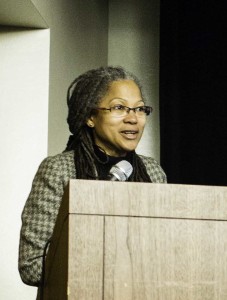 do something about, in the court, Pigford, and so born in North Carolina, of course, we get the main plaintiff [Timothy Pigford], who up to this point had been trying himself to farm and faced all the obstacles that Gary’s family and others, as well as Eddie (Slaughter) will show us, and so when we look at Pigford, we can look at the numbers and the numbers are very, very informing.” She noted “the number of people who filed and recovered the ultimate settlement coming out of Pigford I of a billion dollars – that’s a huge sum of money – but then, when we look at the trillions of dollars, as was projected by some of our fierce leadership, coming out of many places including Detroit and the late great work of Chokwe [Lumumba], mayor in Jackson, Mississippi, and that is the call of reparations,” it becomes clear that there is an “unfinished piece in terms of the settlement of what this society, this great country, in order to come to terms with its soul, really needs to take into account. So when we look at Pigford I, we know that 22,000 farmers had filed and about 15,000 were successful. And at the end of the day, you did have over a billion dollars in settlement. [In terms of] Pigford, there were a number of farmers who had sought to file claims, and they got onto the lists of the ‘late’ and the ‘late-late’, and they got onto government lists that the community, not just BFAA, but the inside-the-Beltway community of people who did their part to make this happen and uplift the World Coalition, the National Family Farm Coalition and others to really press Congress to do the heavy lifting … and in the 2008 Farm Bill we had language in there that would authorize the settlement that would now become Pigford II and allow the ‘late’ and ‘late-late’ filers to participate in a process. And for that process, as Spencer [Wood] said, it was ridiculed by reportage from the New York Times and bloggers that this was a fraudulent exercise, almost as if to say that the government was also in cahoots with Black farmers, and of course, that had its shade of meaning, because we have a Black President, therefore he [must have been] cutting us some slack. And that is so far from the case. The President is a man of principle, there is a very, very strong showing that would have been a miscarriage of justice, we had allies in Congress that understood that, and so, with hard work of our groups in the Capitol were able to get this done in the Farm Bill.
do something about, in the court, Pigford, and so born in North Carolina, of course, we get the main plaintiff [Timothy Pigford], who up to this point had been trying himself to farm and faced all the obstacles that Gary’s family and others, as well as Eddie (Slaughter) will show us, and so when we look at Pigford, we can look at the numbers and the numbers are very, very informing.” She noted “the number of people who filed and recovered the ultimate settlement coming out of Pigford I of a billion dollars – that’s a huge sum of money – but then, when we look at the trillions of dollars, as was projected by some of our fierce leadership, coming out of many places including Detroit and the late great work of Chokwe [Lumumba], mayor in Jackson, Mississippi, and that is the call of reparations,” it becomes clear that there is an “unfinished piece in terms of the settlement of what this society, this great country, in order to come to terms with its soul, really needs to take into account. So when we look at Pigford I, we know that 22,000 farmers had filed and about 15,000 were successful. And at the end of the day, you did have over a billion dollars in settlement. [In terms of] Pigford, there were a number of farmers who had sought to file claims, and they got onto the lists of the ‘late’ and the ‘late-late’, and they got onto government lists that the community, not just BFAA, but the inside-the-Beltway community of people who did their part to make this happen and uplift the World Coalition, the National Family Farm Coalition and others to really press Congress to do the heavy lifting … and in the 2008 Farm Bill we had language in there that would authorize the settlement that would now become Pigford II and allow the ‘late’ and ‘late-late’ filers to participate in a process. And for that process, as Spencer [Wood] said, it was ridiculed by reportage from the New York Times and bloggers that this was a fraudulent exercise, almost as if to say that the government was also in cahoots with Black farmers, and of course, that had its shade of meaning, because we have a Black President, therefore he [must have been] cutting us some slack. And that is so far from the case. The President is a man of principle, there is a very, very strong showing that would have been a miscarriage of justice, we had allies in Congress that understood that, and so, with hard work of our groups in the Capitol were able to get this done in the Farm Bill.
“So the 60,000 farmers who submitted claims for the ‘late-late’ and ‘late’ filers were eventually reduced substantially. So you got about 15,000 who literally were the only ones who got to a laborious process of which the USDA investigated or, if we were to be very charitable, did their ‘due diligence’ to make sure that its settlement was not ridiculed. They were able to settle some of these claims. And of course, there are many, many, many farmers who were not able to perfect their claims and as well, there were many families who are still struggling with the huge burden of having to file on behalf of deceased relations and getting the paperwork together, and as so often happened within the Black experience, we find ourselves as heirs of farms that we actually farm, and so to establish those types of records and to perfect the claim they now have been going through a lengthy and protracted probate process in state courts, and of course these processes vary from state to state. So that process is still ongoing, and so, I’m thinking by conservative estimates that you really won’t have a full closure to Pigford … until probably later this year, after all the estate matters are settled.
“So, what really is the meaning of all this? And where are we now as Black farmers, as people working with Black farmers? It’s still very much a struggle to get the resources that Black farmers need to continue in agriculture in the way that they need to continue. Land that they cannot recover that they have lost is so very expensive. We find that the increased urbanization and extension out into even the peri-urban areas, for example, you have Black farmers farming in Orange County where I’m from, and by a rough estimate, we have about three left in Orange County in North Carolina. And two of them are caught in heir property, but they have enough money to farm … so, in North Carolina the number of Black farmers is still anywhere from 1200 to 1400, but we’re not sure, because we really don’t understand what the numbers are saying. I know that in North Carolina, some of our NGO groups are really holding up the fact that there had been an increase, in its numbers. … We are seeing an increase in urban agriculture. … But at the end of the day, the large piece of the work, the resources that we need for farmers to continue – those who want to continue into agriculture must be able to. For example, in North Carolina, I think we only have one dairy farmer, and that dairy farmer comes from a farm family that lost 280 acres of land, did not really get anything from Pigford … and even to the extent that, on their own land, they have desecration of a historic gravesite. And so, one would say the phoenix has risen, just for that family to be able to continue … to provide leadership to the community, to mentor a son who would then pick up the mantle of continuing agriculture; it says that, if the playing field is level, we have people, within our families, within our communities, who would choose to continue in agriculture. But we still have to continue to fight, to make sure that there is a program available for that and all adequately funded. For many, many years, the World Coalition and its allies have fought along with the Federation for a receipt for service so that if and when you go into the USDA office you get a receipt. … We need more and more families to engage in that process so we can begin to get a fresh set of data to make sure that those farmers are getting what they need.
“I must say that what is going on with Black farmers is part of an international trend, not just in the United States but internationally, where we find that poor people still have one asset that has now become highly prized, even if it’s in the wetlands, and that is our land. So, with all the land grabbing that is going on internationally, with even the tainting of our pension system, our pension funds and getting involved in these real estate investment trusts, it now heightens the value of land and our concern that we must continue to hold onto land and to work collaboratively with our home-grown institutions. … We have some favorable state law that would allow us to address heir property by using limited liability, by getting together as a family, coming together, forming a board and protecting the land. We have to employ many, many strategies to help us to protect this vital resource because, as a farmer once said to me, ‘God doesn’t make any more new land.’ There is no Terra Nova. There are no new lands to conquer. It’s either you hold onto what you have, or it becomes a ‘lose-lose’. We’ve seen, as is well documented through Professor [Phil] Daniel’s work, the historic role of Black farmers in the Civil Rights Struggle, and in fact I would not be standing here if it were not for Black farmers, during the struggle, that stood up and gave our people strength to fight on and do the marches. So, as we approach the 50th Anniversary of the voting and the uprising [against] what really was an oppressive regime in Alabama and the crossing of the [Edmund] Pettus Bridge, and the March to Montgomery from Selma, we must enshrine within our hearts the struggle to keep the land, to hold on to what we have, and to hold dearly the history. … At the end of the day, what’s most important is that, we as a people engage ourselves and our allies. Maybe we made some mistakes [with legal representation], but to the extent that we engage in struggle to get this settlement done, I think it says a lot for us, but it also says more importantly that when people gather for the greater good, good will happen. We all need to come together for great good, because the Black farmers, their struggle for the land, the struggle for safe food, the farmworkers’ struggle, the immigration struggle, the struggle to protect our environment, those are what we are charged as human beings to do, and if we step back and allow the destruction of the Mother Earth, then what’s the point of any of this? So please, let’s rededicate our lives in this season to great good, and to protect our Mother.”
Gary Grant, President, BFAA
The original Pigford settlement was for $2.4 billion, as Mr. Grant explained, “the largest civil rights settlement in the history of this country, and that was done by a bunch of Black farmers. When you think of farmers … back in 1996 they thought we had one strap [of their coveralls] hooked up, and we couldn’t hardly talk … but we got the government to settle for $2.4 billion. That’s enough to buy one bomber. … The community from which I come, the government purchased the land at $25 an  acre back in the 1930s. … You can calculate 10,000 acres of land at $25 an acre. Today, that land would sell for, if we were selling farmland, somewhere between two and three thousand dollars an acre, and if we were selling is as development for housing and stores and towns to be built, it would sell for somewhere between 25 to 30 thousand dollars an acre. That’s [getting close to] a half billion dollars. Right in one spot. That’s an economic base that no one wants to talk about. And yet, they are trying to take it back. No, they aren’t trying to take it, they’re stealing it, that’s what they’re doing. … We’re talking about saving us, is what we’re talking about. Our acronym is BFAA [“Be-Fa”]. And we say, Ebonically speaking, we have Been-Fa everybody else. It’s time that we Be-Fa us.”
acre back in the 1930s. … You can calculate 10,000 acres of land at $25 an acre. Today, that land would sell for, if we were selling farmland, somewhere between two and three thousand dollars an acre, and if we were selling is as development for housing and stores and towns to be built, it would sell for somewhere between 25 to 30 thousand dollars an acre. That’s [getting close to] a half billion dollars. Right in one spot. That’s an economic base that no one wants to talk about. And yet, they are trying to take it back. No, they aren’t trying to take it, they’re stealing it, that’s what they’re doing. … We’re talking about saving us, is what we’re talking about. Our acronym is BFAA [“Be-Fa”]. And we say, Ebonically speaking, we have Been-Fa everybody else. It’s time that we Be-Fa us.”
Eddie Slaughter, Georgia Black Farmer
Eddie Slaughter has a somewhat different take on the Pigford lawsuit and settlement. While he does not dispute the historical significance of Pigford, his view is from the perspective of the farmers themselves, who, despite the settlement, often saw their difficulties continuing because of the duplicity of politicians and government officials. While the legal battle may have been won to some degree as a result of Pigford I and II, the practical reality and the legacy of the settlements in terms of the lives of the Black farmers themselves was often quite different.
As Mr. Grant stated during his introduction and also after Mr. Slaughter’s statement, “That’s a farmer who experienced Pigford and yet … the Honorable Judge [Paul] Friedman said that the settlement was fair and equitable. … So, that’s when someone else is doing the defining, and the loss of 7 million acres of [Black-owned] land is a loss of foundation, economic foundation.” But now, let us hear from Mr. Slaughter himself:
“My name is Eddie Slaughter. I’m from a little small town in Georgia called Buena Vista, Georgia. We commonly call it God’s Country, even though the government is trying to take it back. I know nothing good to say about Pigford. I was one of the participants in it. I’m worse off now, and most of the farmers you’ll talk to are worse off now than they were before Pigford. And there’s a good case that I want to talk to you all about. And his name is Harry Young. He died about three years ago. He was 83 years old. And Harry Young had a farm in Orangeboro, Kentucky. He had $750 million in coal and oil reserves on his farm. He went down to USDA at that time and paid it off. And they took the hundred-some thousand dollars and put it in an escrow account and a couple of years later they started foreclosing on him. And he went to court time and time again, as we’ve been going to court, and with no results. So, finally, what they do to most farmers when they come into being Black, they like the idea that when you stand up and tell the law “this isn’t right” or “that’s wrong”, they say, “Oh, you’re threatening me, you’re intimidating me.” So guess how this case finally got to court? When they took him to court for threatening a USDA Loan Officer. They came in there … and the man took the witness stand, trying to send [Mr. Young] to prison after they robbed him out of his 350 acres of land that had $750 million of coal and oil reserves on it. And so [Mr. Young’s legal team] presented the receipt showing he had paid the farm off, and the [USDA Officer] had to admit that was his signature and the farm had in fact been paid off. And guess what? Like most Black farmers, he died before he could get the settlement. And I mean, that’s a moral disgrace. That’s just one of the [cases]. The Pigford law suit, I’m one of the ones that claim that it’s a fraud. Because I don’t know of no Black farmer that’s received justice out of that lawsuit. Equal justice under the .aw does not exist in America for the Black and the poor. And that’s the harsh reality of Pigford.
“You got the $50,000 and you got all of your land returned back to you in the form of debt relief, but then nobody wants to talk about what we’re going through as a result of the persecution of this lawsuit for us that’s actually on the land and making a living on the farm. ‘Okay, we gave you the $50,000 in 2001.’ [Then, they came back with] ‘Oh, we made a mistake!’ And they took back the debt relief. And they put the lien back on. And for nine years, they offset my Social Security Disability check for $300 a month. And it made my credit bad. I couldn’t pay my creditors. … And  even worse than that, the money that they were taking from me for nine years to pay off the debt that I owed that they put back against me, illegally – they informed me, ‘Mr. Slaughter, the interest has eaten it up.’ [Thus, the principal on the newly-imposed debt remained unchanged – Editor.] … and then, even worse than that, not just me, but [they did this to] others. You all remember back when they bought out the peanut quotas for farmers? White farmers got all their hundreds of thousands, millions of dollars. They said ‘Mr. Slaughter, your little old $11,000 is going to pay down your debt.’ [So, they truly received no debt relief, as their debts were never actually paid in full during the farming.] Then, they came up and bought out the cotton allotments, and all the [Black] farmers, Willie Head, Carl Parker, all of them, they [were told] ‘We’re sorry but you all can’t get yours because you’re still in debt to USDA, so we’re putting that against your loan.’ When we demand that we have a statement showing us where all this money is going, we’ve got to go to court, to try to make them produce to show where this money is going. They haven’t.
even worse than that, the money that they were taking from me for nine years to pay off the debt that I owed that they put back against me, illegally – they informed me, ‘Mr. Slaughter, the interest has eaten it up.’ [Thus, the principal on the newly-imposed debt remained unchanged – Editor.] … and then, even worse than that, not just me, but [they did this to] others. You all remember back when they bought out the peanut quotas for farmers? White farmers got all their hundreds of thousands, millions of dollars. They said ‘Mr. Slaughter, your little old $11,000 is going to pay down your debt.’ [So, they truly received no debt relief, as their debts were never actually paid in full during the farming.] Then, they came up and bought out the cotton allotments, and all the [Black] farmers, Willie Head, Carl Parker, all of them, they [were told] ‘We’re sorry but you all can’t get yours because you’re still in debt to USDA, so we’re putting that against your loan.’ When we demand that we have a statement showing us where all this money is going, we’ve got to go to court, to try to make them produce to show where this money is going. They haven’t.
“The reason why we’re here is because Howard University, when Professor [Charles] Ogletree was here, he had agreed when he heard about all the grievous things that were going on with Black farmers, ‘We’re going to have a mock trial here.’ And that we were going to get all these farmers from across the country and we were going to put on our side of the story. So, when USDA and all the officials got together they said ‘No, no, we’ll settle this here and everything’ and what-have-you. And so, then we went through this Pigford. The biggest problem we got first of all, anybody that benefited from Civil Rights, you need to understand that the Black farmers were the backbone of the Civil Rights Movement. When they started sitting in at Woolworth and Walgreen, and all of these counters across the country, it was the Black farmers and landowners that put the bond and got the bail to get them out of jail. When we were having Freedom Rides … in Virginia, all in North, South Carolina, Alabama, Georgia, Mississippi, Kentucky, wherever they were going, it was the Black farmers and the landowners that went to bond and went to bail. When they had Martin Luther King locked up in Albany, Georgia, threatened to send him to Reedsville Prison, one of the worst prisons in the state of Georgia – which he would have been safe there because the Brothers were saying if y’all send him we’re going to protect him – but the farmers, in Mitchell, Baker and Brooks County said if they give Dr. King a bond, even if it’s a million dollars, we’ve got the land to go to bond and go to bail. So, we need to understand the reason why we need this. If we had to fight that same struggle today we’ve lost so much land it would be a struggle for us to put up the bond and the bail to defend our people.
“I’ve got seven children and all of them know all of the health problems I’ve had from fighting such a fight that you can’t win. Right now, while I’m standing here, Rod Bradshaw in Jetmore, Kansas, has 4,000 acres of land that USDA is trying to foreclose on. Right now, as we speak, [another farmer] already lost his land in Kentucky. Lucius Abrams in Keysville, Georgia is going to court to try to save his 750 acres of land for his family. And let me tell you what USDA did for the actual landowners, Black farmers, the ones who are actively participating in the land. What they did, they closed these cases out, without even a hearing. So, when they went down to try to take the land, USDA did, and the … County Commissioner there … kind of knew the local authorities, and [Mr. Abrams] filed this injunction saying that ‘we demand that the Fifth Amendment to the Constitution, Due Process, be enforced’ and that he had not had due process even in the Pigford case, even as he was a lead plaintiff in Pigford. So when they got there and they brought their side, USDA brought the records showing that Michael Lewis, the adjudicator in the Pigford lawsuit, stated in court ‘yeah, we threw out a bunch of cases … not just me as an adjudicator, but all across the country’. … If they were legitimate cases, and they were over the thousands of dollars in damages, they were thrown out.
“So now, they said ‘We don’t want to deal with this in Burke County, Georgia. We want to transfer it back to Washington, DC, to Judge Paul Friedman. And so, what happened was, the Attorney General of the state of Georgia, as well as the Superior Court in Burke County, said ‘Look, why is this such a problem? The man has not had a hearing, clearly, you all admit that, the man is here, and the land is here, so Subject Matter Jurisdiction means that the hearing should be in Georgia.’ But because of this all-powerful government and the Justice Department, they move it back to Washington, DC under Judge Garcia. He looked at it, read it and said ‘Oh, no.’ So they sent all our cases back to Judge Friedman. And guess what? … Before we could get back to Georgia, the … letter was in the mail there that Judge Friedman had thrown it out again. Now, if you think that Pigford was for good, explain to me why we got over 14,000 cases before USDA, the Administrative Law Judges and none of them are being heard because you’ve got a Black man that they had in charge of the United States Department of Agriculture … Assistant Secretary for Civil Rights [who] actually has done us worse service than our White brothers would have done. Matter of fact, I rather would have had one of the Klansmen running around here with that Rebel Flag on him, because one thing about it, when we do it to each other, we make sure that it’s worse. Not only am I going to stab you in your back, but I’m going all the way to the bone with it. And if you aren’t going down, I’m not pulling the knife out. I might twist it a little bit to make sure you go on down. … This stuff here, the Pigford lawsuit … all of the actual Black farmers except for a very, very few, that are still on the land and farming to make a living, they are being persecuted. … [The USDA and government officials] are making their credit bad. We can’t go back into USDA … because the Secretary of Agriculture, Tom Vilsack, said ‘well this happened 10 or 15 years ago, no sense in me firing these folks [who failed to protect the Black farmers] now.’ So … if we go back into USDA now, it’s a hostile environment for Black farmers. It is clearly an adversarial relationship and they are very arrogant. … But we … the actual farmers, are being persecuted because of this Pigford lawsuit. … And I personally don’t know one Black farmer that received justice.”
Dr. Ridgely A. Mu’min Muhammad of Muhammad Farms, and a member of BFAA, wrote an article in The Farmer dated October 21, 1999 on the just-completed Pigford I settlement, titled “Another Slap in the Face” (http://muhammadfarms.com/farmer-Oct-27-99.htm). Dr. Muhammad would speak later in the 2015 BFAA Land Loss Summit. We will include some of his remarks in a future article.

